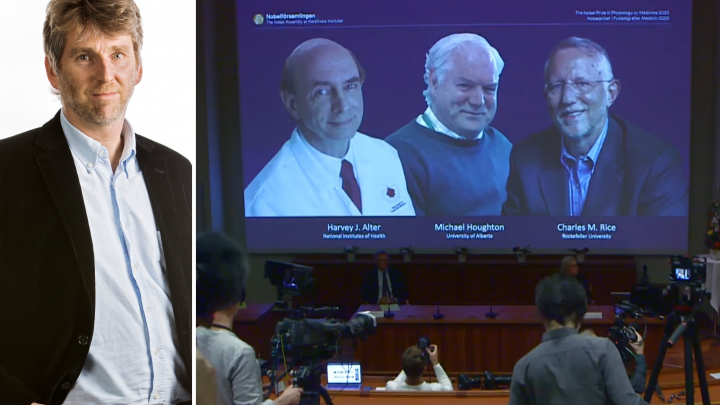
NOBEL PRIZE. This year’s Nobel Prize in Physiology or Medicine recognizes the discovery of the hepatitis C virus, which has saved millions of lives around the world. “It’s a very well-deserved Nobel Prize. Thanks to their findings, it was possible to end the spread of hepatitis C through blood transfusions,” notes Martin Lagging, professor at the University of Gothenburg and expert on hepatitis C viral infection.
On Monday, the Nobel Assembly at Karolinska Institutet announced that the 2020 Nobel Prize in Physiology or Medicine is shared equally by Harvey J. Alter, Michael Houghton, and Charles M. Rice for the discovery of the hepatitis C virus.
“The discoveries that led to identifying the virus quickly resulted in new diagnostic methods that allowed doctors to prevent the spread of the hepatitis C virus, which had previously been an issue in blood products. More long-term, it led to the development of the new anti-viral drugs we use today, where virtually everyone is cured with the same side effect profile as a placebo,” says Martin Lagging, professor of clinical virology at Sahlgrenska Academy, University of Gothenburg, and one of Sweden’s leading experts on hepatitis C.
Saved millions
The discovery started the rapid development of blood tests and effective drugs against the hepatitis C virus. Millions of lives have already been saved. The World Health Organization (WHO) estimates that there are approximately 71 million people worldwide infected with hepatitis C, but thanks to effective treatment, researchers can envision eradicating the virus globally, says Martin Lagging:
“The new antiviral drugs introduced in 2014 have revolutionized the care of people infected with hepatitis C, as most are cured after only eight to twelve weeks of treatment with minimal side effects. This makes it possible for the WHO to achieve its goal of eliminating the hepatitis C virus globally, i.e. to reduce the incidence of new cases by at least 90% by 2030.”
Cirrhosis of the liver and liver cancer
Hepatitis is the inflammation in the liver caused by the virus. The disease is divided into two main groups, based on how it is transmitted. Hepatitis A is transmitted through contaminated water and food and often heals on its own, while hepatitis B is transmitted through blood and body fluids, and if the infection becomes chronic, it carries a high risk of cirrhosis and liver cancer. The discovery of the hepatitis B virus resulted in Baruch Blumberg receiving the 1976 Nobel Prize. However, it was only once the hepatitis C virus had been discovered that all the cases of blood-borne hepatitis could be explained.
Three share the prize
At the NIH Clinical Center’s Department of Transfusion Medicine, Harvey J. Alter studied hepatitis in patients who received blood transfusions and realized that alarmingly many suffered from chronic hepatitis, even though they were not infected with either hepatitis A or B. His work to identify the hepatitis C virus took over ten years. At the time, Michael Houghton was active at the pharmaceutical company Chiron, where he carried out the painstaking work of isolating the newly identified virus’s genome. Charles M. Rice finally demonstrated that the hepatitis C virus alone can cause hepatitis.
TEXT: ELIN LINDSTRÖM










